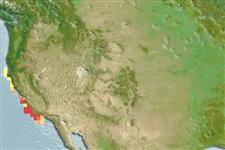Thaliacea |
Doliolida |
Doliopsidae
Environment: milieu / climate zone / depth range / distribution range
Ecology
Pelagic; depth range 160 - 400 m (Ref. 3526). Subtropical
Eastern Central Pacific: USA.
Length at first maturity / Size / Weight / Age
Maturity: Lm ? range ? - ? cm
It is bioluminescent, hermaphroditic, and about one zooid in ten is peppered with orange pigment spots (Ref. 3526).
Life cycle and mating behavior
Maturity | Reproduction | Spawning | Eggs | Fecundity | Larvae
Members of the order Doliolida includes clonal and sexual phases in its life cycle. Life cycle: The doliolid nurse (oozoid, a colony of polymorphic zooids) develops from a fertilized egg and subsequent tadpole larva. The colony arose by budding from the oozoid's stolon, each buds migrate and lodge to the oozoid's spur where they began developing into trophozooids (feed the phorozooids). Buds attached to the phorozooids develop into sexually reproductive gonozooids.
Robison, B.H., K.A. Raskoff and R.E. Sherlock 2005 Ecological substrate in midwater: Doliolula equus, a new mesopelagic tunicate. J. Mar. Biol. Ass. U.K. 85:655-663. (Ref. 3526)
IUCN Red List Status
(Ref. 130435: Version 2025-1)
CITES status (Ref. 108899)
Not Evaluated
Not Evaluated
Threat to humans
Harmless
Human uses
| FishSource |
Tools
More information
Trophic EcologyFood items (preys)
Diet composition
Food consumption
Predators
Population dynamicsGrowth
Max. ages / sizes
Length-weight rel.
Length-length rel.
Length-frequencies
Mass conversion
Abundance
Life cycleReproductionMaturityFecunditySpawningEggsEgg developmentLarvae PhysiologyOxygen consumption
Human RelatedStamps, coins, misc.
Internet sources
Estimates based on models
Preferred temperature
(Ref.
115969): 7.8 - 8.1, mean 7.9 (based on 5 cells).
